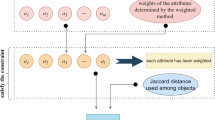Abstract
Feature engineering has been widely used in the fields of pattern recognition, data mining and machine learning. Its main application is feature selection. As an excellent branch of feature selection, rough set attribute reduction has also been greatly developed in recent years, but classical rough set can only deal with discrete data. In view of this, combined with space partition, this paper proposes an efficient rough set attribute reduction theory, which makes the current model suitable for not only discrete data sets, but also continuous data sets and obtains an efficient rough set algorithm. The experimental results show that the algorithm reduces the number of attributes and uses the classifier KNN to test the accuracy of attribute reduction. Compared with the existing algorithms, it shows great advantages.
Access this chapter
Tax calculation will be finalised at checkout
Purchases are for personal use only
Similar content being viewed by others
References
Dash, M., Liu, Y.: Feature selection for classification. Intell. Data Anal. 1(3), 131–156 (1997)
Pawlak, Z.: Rough sets. Int. J. Comput. Inform. Sci. 11(5), 341–356 (1982)
Ma, W., Huang, Y., Li, H., Li, Z., Jiao, L.: Image segmentation based on rough set and differential immune fuzzy clustering algorithm. J. Softw. 25(11), 2675–2689 (2014)
Qian, Y., Liang, X., Wang, Q., Liang, J., Dang, C.: Local rough set: a solution to rough data analysis in big data. Int. J. Approximate Reasoning 97, 38–63 (2018)
Vidhya, K., Geetha, T.: Entity resolution framework using rough set blocking for heterogeneous web of data. J. Intell. Fuzzy Syst. 34(1), 659–675 (2018)
Hu, M., Yao, Y.: Structured approximations as a basis for three way decisions in rough set theory. Knowl. Based Syst. 165, 92–109 (2019)
Yao, Y., Wong, S., Lingras, P.: A decision-theoretic rough set model. Methodol. Intell. Syst. 17–24 (1990)
Ziarko, W.: Variable precision rough set model. J. Comput. Syst. Sci. 46(1), 39–59 (1993)
Li, Z., Fan, J., Ren, Y., Tang, L.: A novel feature extraction approach based on neighborhood rough set and PCA for migraine rs-fMRI. J. Intell. Fuzzy Syst. 38(6), 1–11 (2020)
Luo, S., Miao, D., Zhang, Z., Zhang, Y., Hu, S.: A neighborhood rough set model with nominal metric embedding. Inf. Sci. 520, 373–388 (2020)
Wang, C., Qi, Y., Shao, M., Hu, Q., Chen, D., Qian, Y., Lin, Y.: A fitting model for feature selection with fuzzy rough sets. IEEE Trans. Fuzzy Syst. 25(4), 741–753 (2017)
Zhang, K., Zhan, J., Wang, X.: TOPSIS-WAA method based on a covering-based fuzzy rough set: an application to rating problem. Inf. Sci. 539, 397–421 (2020)
Zhang, W., Chen, H.: Hyperspectral band selection algorithm based on kernelized fuzzy rough set. J. Comput. Appl. 40(1), 258–263 (2020)
Dai, J., Hu, H., Wu, W., Qian, Y., Huang, D.: Maximal-discernibility pair-based approach to attribute reduction in fuzzy rough sets. IEEE Trans. Fuzzy Syst. 26(4), 2174–2187 (2017)
Hu, Q., Yu, D., Xie, Z.: Numerical attribute reduction based on neighborhood granulation and rough approximation. J. Softw. 19(3), 640–649 (2008)
Gu, Q., Li, Z., Han, J.: Generalized Fisher score for feature selection. In: CoRR (2012)
Roffo, G., Melzi, S.: Ranking to learn: feature ranking and selection via eigenvector centrality. In: CoRR, pp. 19–35 (2017)
Roffo, G., Melzi, S., Castellani, U.: Infinite feature selection: a graph-based feature filtering approach. IEEE Trans. Pattern Anal. Mach. Intell. 43(12), 4396–4410 (2020)
Roffo, G., Melzi, S., Castellani, U., Vapnik, A.: Gene selection for cancer classification using support vector machines. Mach. Learn. 46(1–3), 389–422 (2002)
Guo, J., Guo, Y., Kong, X., He, R.: Unsupervised feature selection with ordinal locality. In: Proceedings of IEEE International Conference on Multimedia and Expo, pp. 1213–1218 (2017)
Guo, J., Zhu, W.: Dependence guided unsupervised feature selection. In: Proceedings of the AAAI Conference on Artificial Intelligence, vol. 32(1) (2018)
Bradley, P., Mangasarian, O.: Feature selection via concave minimization and support vector machines. In: Proceedings of theInternational Conference on Machine Learning, vol. 98, pp. 82–90 (1998)
Hu, Q., Zhao, H., Yu, D.: Efficient symbolic and numerical attribute reduction with neighborhood rough sets. Pattern Recognit. Artif. Intell. 21(6), 730–738 (2008)
Gao, Y., Liu, Z., Ji, J.: Neighborhood rough set attribute reduction algorithm based on matrix reservation strategy. Appl. Res. Comput. 32(12), 3570–3573 (2019)
Peng, X., Liu, Z., Ji, J.: Adaptable method for determining neighborhood size of neighborhood rough set. Appl. Res. Comput. 36(327), 150–153 (2019)
Xia, S., Zhang, Z., Li, W.: GBNRS: a novel rough set algorithm for fast adaptive attribute reduction in classification. IEEE Trans. Knowl. Data Eng. 1–1 (2020)
Xia, S., Zheng, Y., Wang, G.: Random space division sampling for label noisy classification or imbalanced classification. IEEE Trans. Cybern. 1–14 (2021)
UCI Homepage. https://archive.ics.uci.edu/ml/index.php. Last accessed 2021/06/05
Acknowledgements
This work was supported in part by the National Key Research and Development Program of China under Grant No. 2019QY(Y)0301, National Natural Science Foundation of China under Grant Nos. 61806030 and 61936001, the Natural Science Foundation of Chongqing under Grant Nos. cstc2019jcyj-msxmX0485 and cstc2019jcyj-cxttX0002 and by NICE: NRT for Integrated Computational Entomology, US NSF award 1631776.
Author information
Authors and Affiliations
Corresponding author
Editor information
Editors and Affiliations
Rights and permissions
Copyright information
© 2022 The Author(s), under exclusive license to Springer Nature Singapore Pte Ltd.
About this paper
Cite this paper
Wu, S., Xia, S., Chen, X. (2022). A Novel Space Division Rough Set Model for Feature Selection. In: Jain, L.C., Kountchev, R., Tai, Y., Kountcheva, R. (eds) 3D Imaging—Multidimensional Signal Processing and Deep Learning. Smart Innovation, Systems and Technologies, vol 297. Springer, Singapore. https://doi.org/10.1007/978-981-19-2448-4_7
Download citation
DOI: https://doi.org/10.1007/978-981-19-2448-4_7
Published:
Publisher Name: Springer, Singapore
Print ISBN: 978-981-19-2447-7
Online ISBN: 978-981-19-2448-4
eBook Packages: Intelligent Technologies and RoboticsIntelligent Technologies and Robotics (R0)




